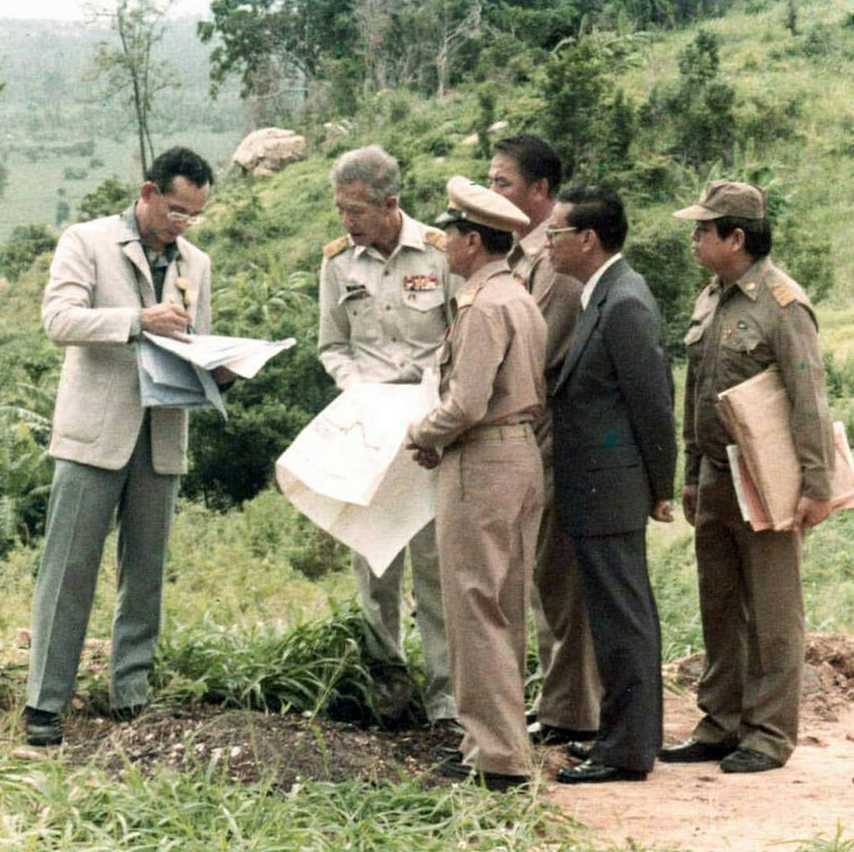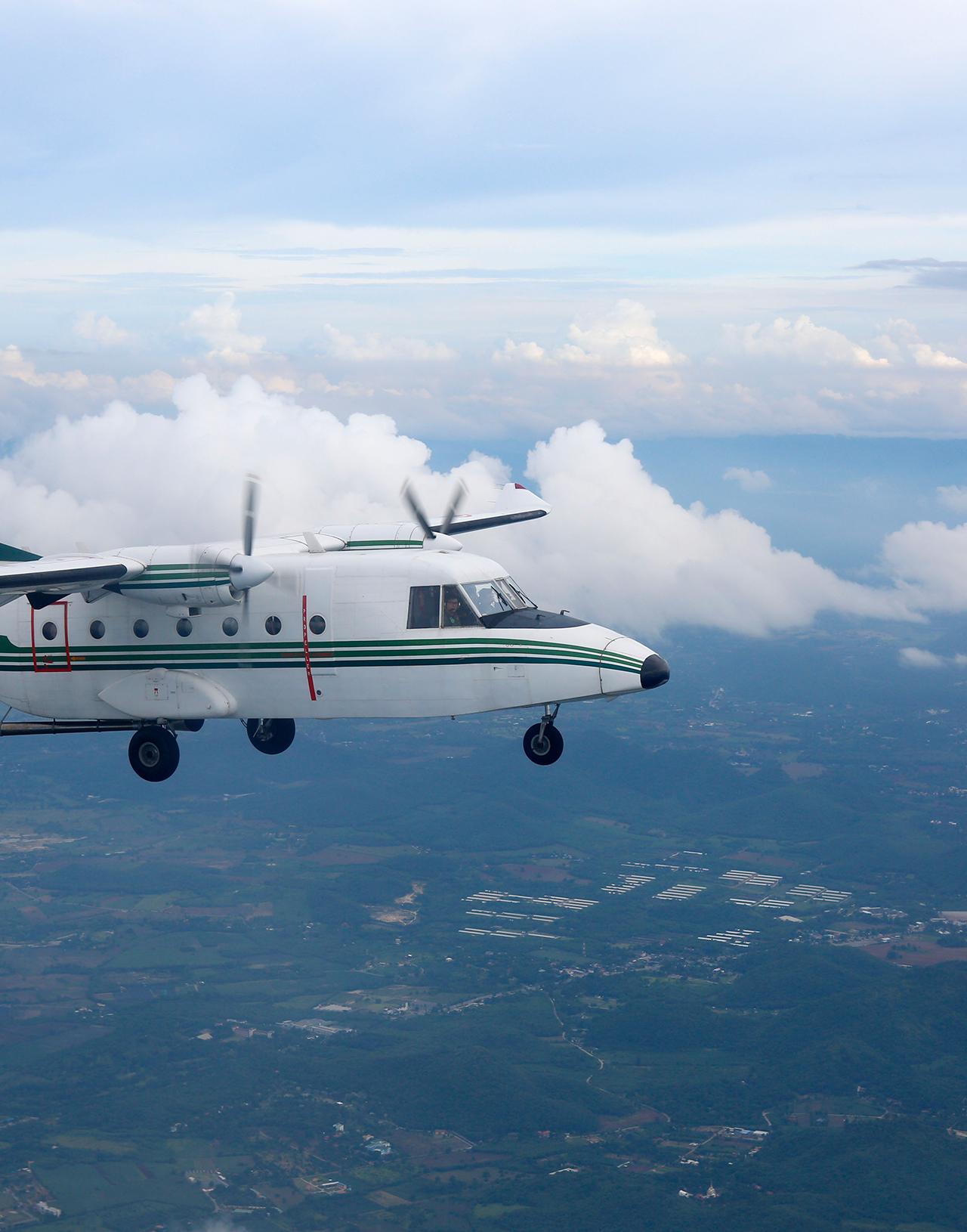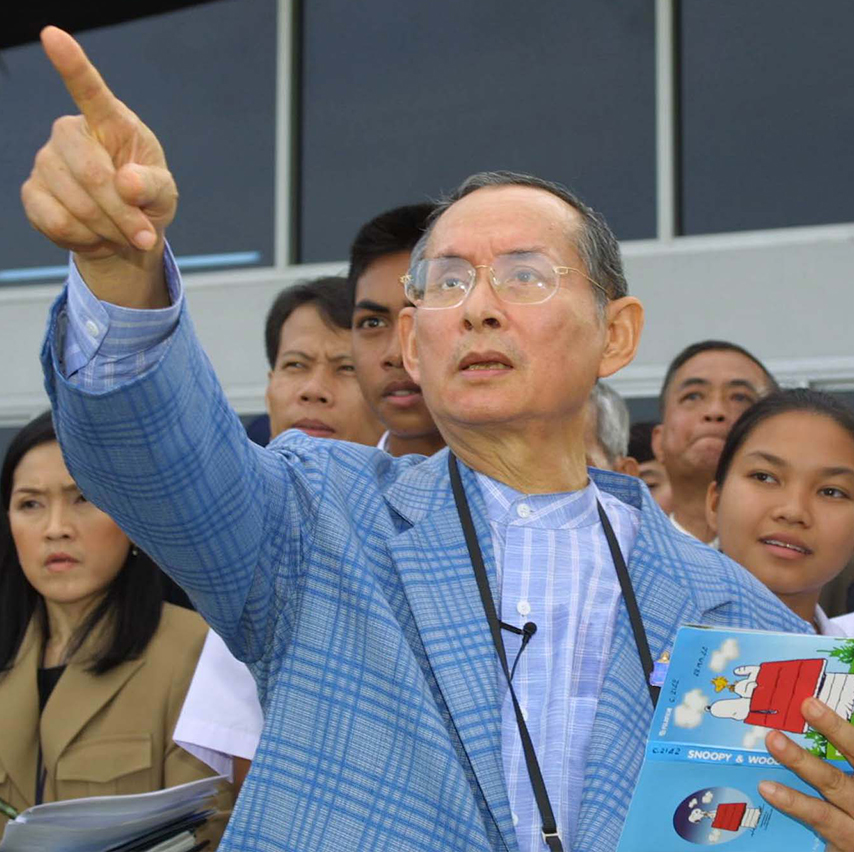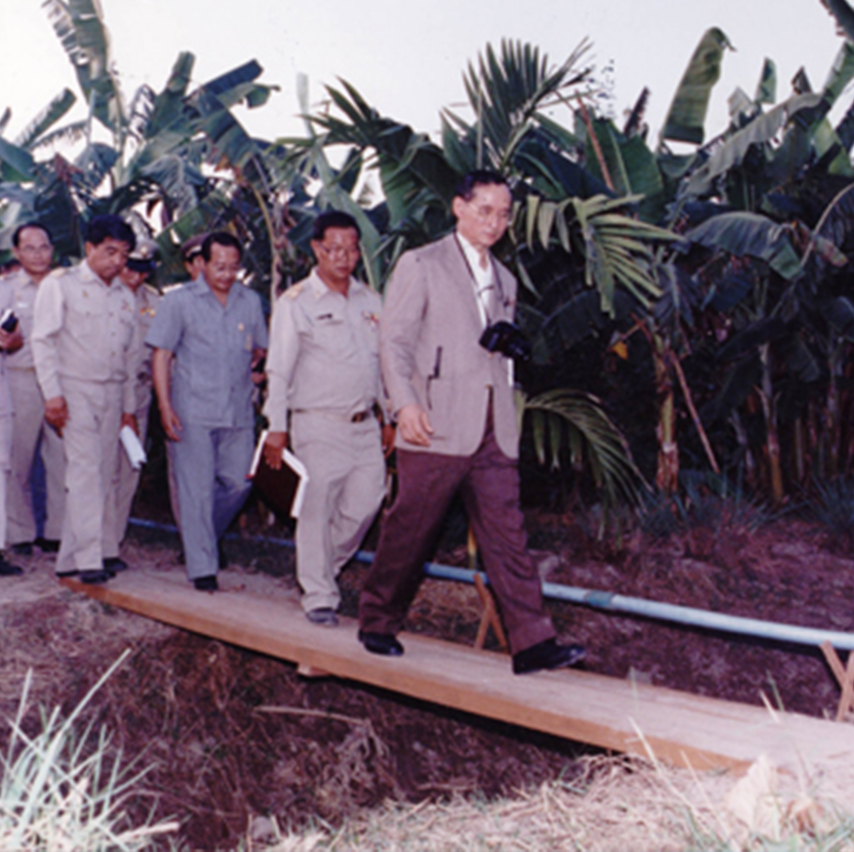





-


Seeds of sufficiency now flourishing
HM King Rama IX's legacy is still lifting thousands out of rural poverty each year
Writer: Chatrudee Theparat
Though it's been three years since the passing of the country's revered monarch, Pid Thong Lang Phra Foundation, a royally sponsored initiative applying the sufficiency economy philosophy, is still keen to uphold King Rama IX's legacy of caring for rural communities.
Its chairman MR Disnadda Diskul confirms the foundation is still working hard to improve living standards for rural folk.
MR Disnadda said the sufficiency-economy philosophy of His Majesty King Bhumibol Adulyadej The Great was introduced to Thais five decades ago, but is still a vital solution for problems in society.
The chairman said he now wants to see more Thais adopt that knowledge to solve problems in their own lives.
The Pid Thong Lang Phra Foundation is showing the way by teaching the art of applying Rama IX's ideas. The results so far are impressive: thousands of households in designated rural areas are using sufficiency-economy "tools" to boost their quality of life.
Those tools are being adopted to tackle problems of severe deforestation, land use and shortage of water sources, in a model development project the foundation has implemented in several provinces. The key to its success is getting locals to participate in the solutions to their problems.
The tools are passed on through learning activities that show local communities how to apply the late King’s development thinking in practical ways. In this way they are able to manage problems and control their own destiny.
The foundation was founded nine years ago with a mission to integrate the public and private sectors as well as civil society in finding development solutions for society, he said.
Under its first strategy, the foundation applied sufficiency philosophy from 2009 to 2015 in eight rural districts of five provinces — Nan, Udon Thani, Kalasin, Uthai Thani and Phetchaburi.
The strategy was to help the communities build infrastructure for water supply, soil conservation, rehabilitation of their natural resources, and job creation. As a result, living standards for 7,990 families in the districts have risen significantly, said MR Disnadda.
The families now have access to a clean water supply. Better still, their total annual revenue from farming has increased from 109 million to 1.04 billion baht, he added.
The foundation helped targeted communities set up 70 relief funds with a total 15.78 million baht to help 1,634 families, he said.
The successful application of King Rama IX's ideas saw the five-year project adopted by the government as a nationwide model. The National Economic and Social Development Council (NESDC) made the project a core of its 2014-2017 management plan, according to MR Disnadda.
Under its second strategy (2016-2020), the foundation has extended its development projects in the same five provinces with a goal of helping communities stand on their own feet and achieve long-term self-reliance, he said.
It has also expanded its projects to other provinces, including Khon Kaen, Yala, Pattani, Narathiwat, Nakhon Nayok, Krabi and Roi Et, as well as northern border provinces hit hard by the drugs trade. Elsewhere, the popularity and practicality of sufficiency economy theory has seen four universities open courses on King Rama IX's theory.
The first two phases of the foundation's strategy are also in tune with the United Nation’s Sustainable Development Goals (SDGs), adds MR Disnadda.
First applied in the 1970s, sufficiency economy theory is based on fundamental principles of Thai culture. At its core lie virtues of moderation, prudence, and self reliance as guidelines for living. Significantly, intelligence and perseverance are also emphasised as prerequisites for genuine contentment in one’s life.
MR Disnadda recalled the world economic crisis that hit Thailand hard during its implementation of the 2nd National Economic and Social Development (NESD) plan (1967-1971). It left the country vulnerable to the spectre of communism, while opium cultivation remained a severe problem in northern hilltribe areas.
To address these problems, in 1969 HM King Rama IX set up the first royal project on Doi Pui in Chiang Mai province after visiting an opium-growing hilltribe village on the mountain.
According to MR Disnadda, His Majesty realised the hilltribe could cultivate local peaches instead of opium, an ability which was harnessed by his royally sponsored Doi Pui Development Centre to lift the community out of poverty.
Soon after, the 1973 global oil crisis saw Thai inflation reach 10.3%, leading to a shortage of goods. The crisis was eased with the launch in 1975 of another royally-initiated unit, the Phra Dabos Foundation, to promote education and employment opportunities among young people, he said.
Thailand was hit again when the global energy crisis sent oil prices soaring. Once again, Rama IX responded, initiating a project to produce bio-diesel and gasohol.
The kingdom recovered from the crisis and began industrialising under its 6th NESD plan (1987-1991), but agriculture suffered as a result.
To deal with the impact, His Majesty founded the Huay Mongkol royal development project in Prachuap Khiri Khan's Hua Hin district to boost the agriculture sector.
MR Disnadda notes that the number of royally- initiated projects across the country has since grown to 4,741.
He adds that Rama IX remains the pioneer and guide for sustainable development work in Thailand. Meanwhile Her Royal Highness Srinagarindra The Princess Mother, who founded the Mae Fah Luang Foundation in Chiang Rai, has applied knowledge in her royal projects on Doi Tung mountain since 1988.
The Doi Tung projects, which are aimed at solving drug and poverty problems in the highlands, have now been adopted as a model of sustainable development by the United Nations, he said.
-


The gift that keeps on giving
The late King's rainmaking project finds new use in modern Thailand
Writer: Apinya Wipatayotin
Three years after the passing of His Majesty King Bhumibol Adulyadej The Great, one of his legacies, artificial rainmaking, remains a solution that Thailand can depend on to tackle the problem of air pollution and climate change-induced drought.
Efforts to solve environmental problems such as drought and pollution entails a lot of shift in our behaviour, which takes some time to bear fruit. Replacing fossil fuels with renewable energy sources, planting more trees, and changing mass consumer behaviour take not only just time, but also effort.
By the time these reforms show results, however, it might already too late for anyone to do anything.
Fortunately for Thailand, the country has a weapon up its sleeves to combat the drought and wash away the recent cloud of ultra-fine PM2.5 particulate matters, which has recently blanketed its major cities.
That solution, is artificial rainmaking.
First initiated by the late King to help alleviate drought across the country's agricultural heartland, artificial rainmaking is now used in different ways so that it does not just benefit poor farming communities.
During his reign that spanned seven decades, King Bhumibol extensively toured the country's hinterlands to seek new ways to improve the livelihood of his subjects.
During a visit to the Northeast in November 1955, the young monarch learnt first-hand about the region's crippling water shortages, which contributed to the region's status as the poorest in the nation.
Upon returning to Bangkok, the monarch invited engineer MR Thepparit Devakul to discuss the feasibility of artificially-inducing rain.
The project took up a lot of time and effort. In fact, the late King spent 14 years studying about artificial rainmaking before the first field trial was carried out at Nakhon Ratchasima's Khao Yai National Park on July 1-2, 1969.
The trial's result was encouraging and ever since then, artificial rainmaking has been used to help address water shortages in drought-prone areas. Foreign countries, such as Jordan, have also adopted the late King's approach to solve water shortages in their respective countries.
The seeding is done by dispersing salt to absorb moisture in the atmosphere to "fatten" the cloud, as well as dropping dry ice from a height of 10,000 feet to "tighten" the cloud formation.
Back in 2001, King Bhumibol's Royal Rainmaking Project was recognised by the Eureka organisation as an initiative that could benefit the entire world.
The "Weather Modification by Royal Rainmaking Technology" was then registered with the Department of Intellectual Property under the Ministry of Commerce and was given the patent No.13898 on Nov 29, 2002.
Unsurprisingly, the method was also registered in other countries. For instance, the European Patent Office (EPO) issued patent No.1491088 on Sept 17, 2003 for the late King's weather modification technique.
While it has been some time since the monarch who inspired the technology passed away, the Department of Royal Rainmaking and Agricultural Aviation (DRRAA) remains active and is busier than ever.
DRRAA chief, Surasri Kidtimonton, said the demand of artificial rainmaking has jumped because of the increasing frequency and intensity of drought and air pollution problems.
This year, he said, DRRAA conducted about 6,000 rain-seeding flights — exceeding the average annual number of about 5,000.
As a result, DRRAA pilots have been working all year without any holidays.
"The department belongs to the late King Rama IX. I've worked here since the very beginning and I have no intention of moving anywhere because I am working for our beloved King," he said.
"He is a great inspiration to me and others."
There are currently about 71 pilots working across five Royal Rain Operations Centre offices in Chiang Mai, Nakhon Sawan, Khon Kaen, Rayong, and Surat Thani — but there are plans to open centres in Buri Ram and Phitsanulok soon.
Therefore, DRRAA is requesting permission to hire 44 more pilots to meet the increasing demand for artificial rainmaking, especially since the department is planning to procure seven more aircraft to bolster its operations.
At present, DRRAA has an annual budget of about two billion baht, which it uses to operate 39 rain-seeding planes. Out of the 39 planes, 25 of them have been in service for over two decades.
Recently, the department lost one of its pilot instructor and a student in a plane crash in Kanchanaburi. The plane, which was on a training mission, went missing from ground control radars, only to be found crashed and broken into mangled pieces.
Mr Surasri said that everyone in the department was saddened by the tragedy.
"That said, none of us felt discouraged because we all understand that we are now working for the King, so we have to do what we can and carry out our work despite the staff shortage," he said.
"I believe everyone [in the department] feel the same way I do, that it is a great honour to be working for such a great King who had only one thing in his mind — that is, to benefit his people."
While cloud-seeding remains DRRAA's main strategy, it isn't dwelling on it. In fact, the department is currently working with a number of research institutes to find out ways to improve the accuracy and efficiency of the process.
"Climate change has caused weather patters to change in a quick and unpredictable way and it reduces humidity in the air, so our artificial rainmaking technology has to be updated to cope with a hotter and drier world," he said.
"As such, we are truly lucky to be working with a great team who are willing to work with the limited resources we have."
-


The road to rural success
When His Majesty King Bhumibol Adulyadej The Great thought of ways to improve the quality of life of his people, particularly residents in remote villages, he realised the link between new roads and better living.
Writer: Thodsapol Hongtong
Throughout his 70 years on the throne, King Rama IX initiated many projects to build roads across the country, believing they would not only take travellers to destinations, but would also lead people to live healthier lives.
Roads are a key form of infrastructure and play an important role in boosting local economies as they facilitate the transport of goods and turn little-known areas into tourist attractions.
These transport developments, which are largely thanks to King Rama IX, are still vivid in the memories of Thai people, even though he passed away three years ago.
The Department of Rural Roads, which oversees 48,000 kilometres of roads countrywide, worked with the late King to improve villagers' lives by building and upgrading roads.
Although King Rama IX passed away on Oct 13, 2016, officials have continued his work to give faraway areas better access to the national transportation network.
One of the department's major jobs is to build roads linking areas under the late King's development projects, often known as "royal initiatives", with important routes within the country.
So far, it has already built up to 200km of roads to these areas, including the well-known Ao Khung Kraben in tambon Khlong Khut in Chanthaburi's Tha Mai district.
The road to Ao Khung Kraben not only serves as a way to access the area, but is also viewed as a scenic route. It has become the model for a new project which the department calls the "Royal Coast Scenic Route", which will cover more than 1,000km from Samut Sakhon in the Central Plains to Sugnai Kolok district in the southernmost province of Narathiwat.
“It will be the longest coastal road in the world,” the department said. They believe that it will become another major road which will bring economic prosperity to epople along the route, and which will carry on the late King's work on rural development.
King Rama IX initiated the Ao Khung Kraben project 38 years ago in a move to restore the degraded mangrove forest, improve the conservation of marine life and support the careers of coastal fishermen and farmers, all of whom exist within the same ecosystem covering 2,000 rai of land.
The department helped the late King by building a road to the area in 2009, which was later named "Chaloem Burapha Conlatthit".
The 111-km eastern coastal road links three coastal provinces together, stretching from Rayong to Chanthaburi and Trat to the east.
The road starts at Highway No 3161 near the statue of renowned poet Sunthon Phu in Rayong's Klaeng district, runs along the coastlines of Rayong and Chanthaburi and terminates in Trat.
It is the "most beautiful scenic route in Thailand", based on other scenic roads in foreign countries, the department said.
The late King not only inspired the officials to think of roads in terms of economy, but also in terms of aesthetic value.
Motorists can appreciate the beauty of the road as it runs parallel to the sea. The road has also become a favourite among cyclists, and bicycle lanes were also built along the route.
When the route starts to attract more tourists, it will become another source of revenue for locals, the department said.
The department is preparing to urge villagers to sell products made in their neighbourhoods at certain points along the route.
It is also currently building another, similar road to continue the late King's intention to improve the lives of Southerners.
The new road, which spans a distance of 1,000km, aims to boost both the economy and tourism, support the government's Southern Economic Corridor scheme, and turn villages into tourist attractions.
The first phase of the construction of the section of road from Samut Songkham to Chumphon, worth 5.1 billion baht, is making good progress. Workers have already finished building over half of this 658-km stretch. This road is expected to open within the next three years.
Officials will soon move into the second phase by conducting a detailed study of another 600-km section from Chumphon to Songkhla.
They are also planning the third phase, which includes the last two sections of the route – a road from Songkhla to Sungai Kolok and the other from Samut Sakhon to Samut Songkhram.
According to the department, a lighthouse-like building will be built at the start of the route near the 73rd kilometre of Rama II Road to inform drivers and cyclists that they are about to enter the scenic road leading towards the deep South.
The new project is moving forward, and so will the late King's intention to help rural people, now carried on by officials as they follow in King Rama IX's footsteps.
Roads not only give rural people more comfort as they travel, but they also improve local peoples' quality of life.
His Majesty King Bhumibol Adulyadej The Great successfully turned this vision into a mission as he helped improve the lives of his people.




